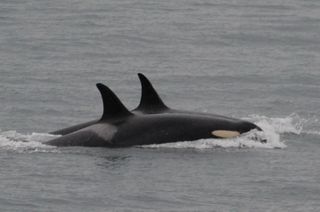Orca Mother, Who Pushed Her Dead Calf for 1,000 Miles and 17 Days, Moves On

Seventeen days ago, a grieving orca mother known as Tahlequah began pushing her dead calf around the waters near Puget Sound. And now, after doing so for 1,000 miles (1,600 kilometers), she has let go.
Tahlequah was spotted without her baby's body on Saturday (Aug. 11), when she was seen chasing a school of salmon with her pod in the Haro Strait, a waterway between the San Juan Islands north of Seattle and Canada's Vancouver Island.
"Her tour of grief is now over, and her behavior is remarkably frisky," according to a blog post from the Friday Harbor, Washington-based Center for Whale Research. [Photos: Drone Reveals Killer Whales]
Tahlequah (who is also known as J35) appears to be in good physical shape and doesn't have any evidence of "peanut head," a condition that indicates that the whale is malnourished as its head bones begin to show, the Center for Whale Research reported.
But the 20-year-old whale's emotional state is unknown. Losing her calf "may have been emotionally hard on her," Ken Balcomb, founding director of the Center for Whale Research, told The Seattle Times. "She is alive and well and at least over that part of her grief. Today was the first day that I for sure saw her. It is no longer there," he added, referring to the dead calf.
It's unclear whether Tahlequah voluntarily stopped carrying the baby's remains or whether they deteriorated and fell away, The Seattle Times reported. The carcass is likely now at the bottom of the Salish Sea, meaning researchers probably won't be able to find it for a necropsy (an animal autopsy), the Center for Whale Research said.

Tahlequah's moving story made headlines around the world when researchers spotted her with her dead calf, which died shortly after it was born on July 24. A few hours after the baby died, a resident of San Juan Island reported seeing Tahlequah with about six other female orcas (Orcinus orca) gathered at the mouth of a cove in a tight-knit circle.
Sign up for the Live Science daily newsletter now
Get the world’s most fascinating discoveries delivered straight to your inbox.
"As the light dimmed, I was able to watch them continue what seemed to be a ritual or ceremony," the resident said, according to the Center for Whale Research's blog. "They stayed directly centered in the moonbeam, even as it moved. The lighting was too dim to see if the baby was still being kept afloat. It was both sad and special to witness this behavior."
The loss of the newborn is tragic, and sadly, it's not out of the blue. None of the calves born to moms in the Southern Resident killer whale group — which consists of the J, K and L pods — have survived over the past three years, the blog reported. As a result, the population is a "species in the spotlight" because of its imminent threat of extinction, according to the National Oceanic and Atmospheric Administration.
The three pods also face other challenges. The orcas have to deal with vessel noise that interrupts them while they're foraging; toxins from the environment that get into their blubber and are released when they, in turn, burn their blubber for energy; and, for many, malnutrition due to a lack of Chinook salmon, The Seattle Times reported. [Photos: The Freakiest-Looking Fish]
In 1995, the Southern Resident killer whale group had a population of 98 whales, but today it is just 75, with 23 in the J pod, 18 in the K pod and 34 in the L pod, the Center for Whale Research said. The whales were listed as endangered in 2006, according to the U.S. Fish and Wildlife Service, Live Science previously reported.
Another member of the J pod, a 4-year-old named Scarlet (or J50), is so malnourished that the Lummi Nation is planning to approach and feed her live salmon to help her survive, The Seattle Times reported.
As for Tahlequah's behavior, researchers say it's common for marine mammals to show signs of grief. For instance, after the Deepwater Horizon oil spill in April 2010, bottlenose dolphins were seen pushing around the bodies of their dead calves, Live Science previously reported.
Original article on Live Science.

Laura is the archaeology and Life's Little Mysteries editor at Live Science. She also reports on general science, including paleontology. Her work has appeared in The New York Times, Scholastic, Popular Science and Spectrum, a site on autism research. She has won multiple awards from the Society of Professional Journalists and the Washington Newspaper Publishers Association for her reporting at a weekly newspaper near Seattle. Laura holds a bachelor's degree in English literature and psychology from Washington University in St. Louis and a master's degree in science writing from NYU.
Most Popular

